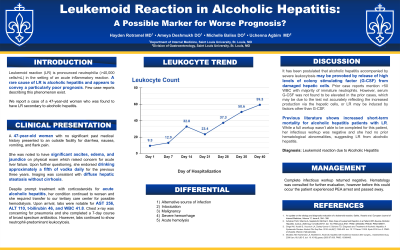Monday Poster Session
Category: Liver
P2517 - Leukemoid Reaction in Alcoholic Hepatitis: A Possible Marker for Worse Prognosis?
Monday, October 23, 2023
10:30 AM - 4:15 PM PT
Location: Exhibit Hall

Has Audio

Hayden Rotramel, MD
Saint Louis University
St. Louis, MO
Presenting Author(s)
Hayden Rotramel, MD1, Ameya Deshmukh, DO2, Michelle Baliss, DO1, Uchenna Agbim, MD2
1Saint Louis University, St. Louis, MO; 2Saint Louis University Hospital, St. Louis, MO
Introduction: Leukemoid reaction (LR) is defined by pronounced neutrophilia ( >50,000 cells/mL) in the setting of an acute inflammatory reaction. It can be secondary to reactive causes occurring outside of the bone marrow. A rare cause of LR is alcoholic hepatitis and conveys a poor prognosis. Few case reports describing this phenomenon exist. We report a case of a 47-year-old woman who was found to have a leukemoid reaction secondary to severe alcoholic hepatitis.
Case Description/Methods: A 47-year-old woman with a history of GERD presented to an outside facility for diarrhea, nausea, vomiting, and flank pain. She was noted to have ascites, edema, and jaundice which raised concern for acute liver failure, and on questioning she endorsed drinking approximately a fifth of vodka daily for the previous three years. Imaging was consistent with diffuse hepatic steatosis without cirrhosis. Although being promptly treated with steroids, she continued to worsen and was transferred to a tertiary care center. Upon arrival, the patient was admitted to the ICU for possible initiation of hemodialysis. Labs were notable for elevated ALT, AST, and total bilirubin. INR was within normal limits. WBC count was significantly elevated at 41.8. Chest x-ray was concerning for pneumonia and she completed a 7-day course of broad spectrum antibiotics. However, labs continued to show neutrophil-predominant leukocytosis (ANC of 45.21 and WBC count of 48.1). Complete infectious workup returned negative. Hematology was consulted for further evaluation, however unfortunately the patient experienced PEA arrest and passed before this could occur.
Discussion: It has been postulated that alcoholic hepatitis accompanied by severe leukocytosis may be provoked by release of high levels of colony stimulating factor (G-CSF) from damaged hepatic cells. Prior case reports mention >50 WBC with majority of immature neutrophils. Serum G-CSF was not found to be elevated in the prior cases. This may be due to the test not accurately reflecting the increased production via the hepatic cells, or the LR may be induced by factors other than G-CSF. Previous literature shows increased short-term mortality for alcoholic hepatitis patients with LRs. While a full workup could not be done in this patient, her infectious workup was negative and she had no prior hematological abnormalities, suggesting LR from alcoholic hepatitis.
Disclosures:
Hayden Rotramel, MD1, Ameya Deshmukh, DO2, Michelle Baliss, DO1, Uchenna Agbim, MD2. P2517 - Leukemoid Reaction in Alcoholic Hepatitis: A Possible Marker for Worse Prognosis?, ACG 2023 Annual Scientific Meeting Abstracts. Vancouver, BC, Canada: American College of Gastroenterology.
1Saint Louis University, St. Louis, MO; 2Saint Louis University Hospital, St. Louis, MO
Introduction: Leukemoid reaction (LR) is defined by pronounced neutrophilia ( >50,000 cells/mL) in the setting of an acute inflammatory reaction. It can be secondary to reactive causes occurring outside of the bone marrow. A rare cause of LR is alcoholic hepatitis and conveys a poor prognosis. Few case reports describing this phenomenon exist. We report a case of a 47-year-old woman who was found to have a leukemoid reaction secondary to severe alcoholic hepatitis.
Case Description/Methods: A 47-year-old woman with a history of GERD presented to an outside facility for diarrhea, nausea, vomiting, and flank pain. She was noted to have ascites, edema, and jaundice which raised concern for acute liver failure, and on questioning she endorsed drinking approximately a fifth of vodka daily for the previous three years. Imaging was consistent with diffuse hepatic steatosis without cirrhosis. Although being promptly treated with steroids, she continued to worsen and was transferred to a tertiary care center. Upon arrival, the patient was admitted to the ICU for possible initiation of hemodialysis. Labs were notable for elevated ALT, AST, and total bilirubin. INR was within normal limits. WBC count was significantly elevated at 41.8. Chest x-ray was concerning for pneumonia and she completed a 7-day course of broad spectrum antibiotics. However, labs continued to show neutrophil-predominant leukocytosis (ANC of 45.21 and WBC count of 48.1). Complete infectious workup returned negative. Hematology was consulted for further evaluation, however unfortunately the patient experienced PEA arrest and passed before this could occur.
Discussion: It has been postulated that alcoholic hepatitis accompanied by severe leukocytosis may be provoked by release of high levels of colony stimulating factor (G-CSF) from damaged hepatic cells. Prior case reports mention >50 WBC with majority of immature neutrophils. Serum G-CSF was not found to be elevated in the prior cases. This may be due to the test not accurately reflecting the increased production via the hepatic cells, or the LR may be induced by factors other than G-CSF. Previous literature shows increased short-term mortality for alcoholic hepatitis patients with LRs. While a full workup could not be done in this patient, her infectious workup was negative and she had no prior hematological abnormalities, suggesting LR from alcoholic hepatitis.
Disclosures:
Hayden Rotramel indicated no relevant financial relationships.
Ameya Deshmukh indicated no relevant financial relationships.
Michelle Baliss indicated no relevant financial relationships.
Uchenna Agbim indicated no relevant financial relationships.
Hayden Rotramel, MD1, Ameya Deshmukh, DO2, Michelle Baliss, DO1, Uchenna Agbim, MD2. P2517 - Leukemoid Reaction in Alcoholic Hepatitis: A Possible Marker for Worse Prognosis?, ACG 2023 Annual Scientific Meeting Abstracts. Vancouver, BC, Canada: American College of Gastroenterology.
